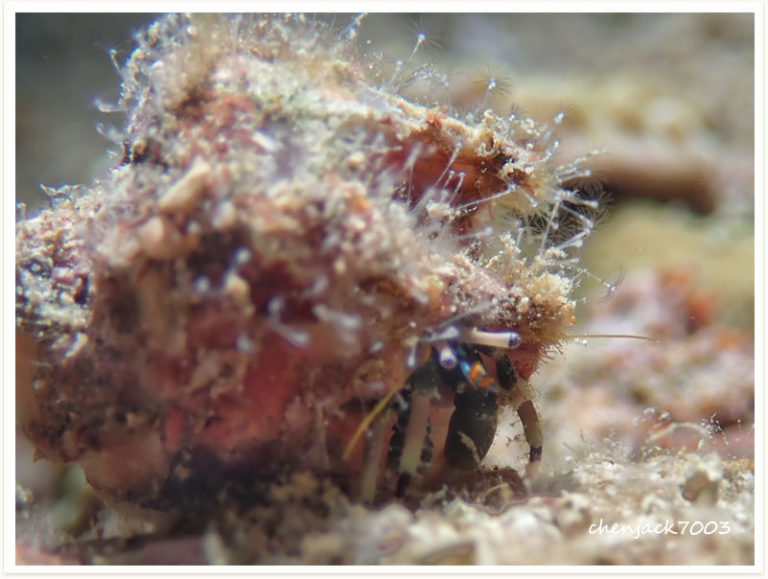垫子海星
Pentaceraster alveolatus is a starfish from the Oreasteridae family.
The scientific name of the species was published in 1875 by Edmond Perrier.
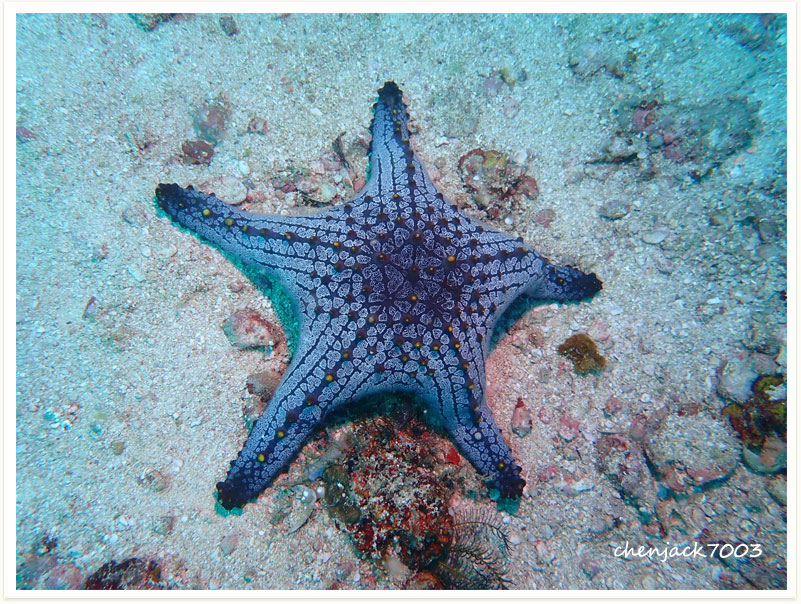
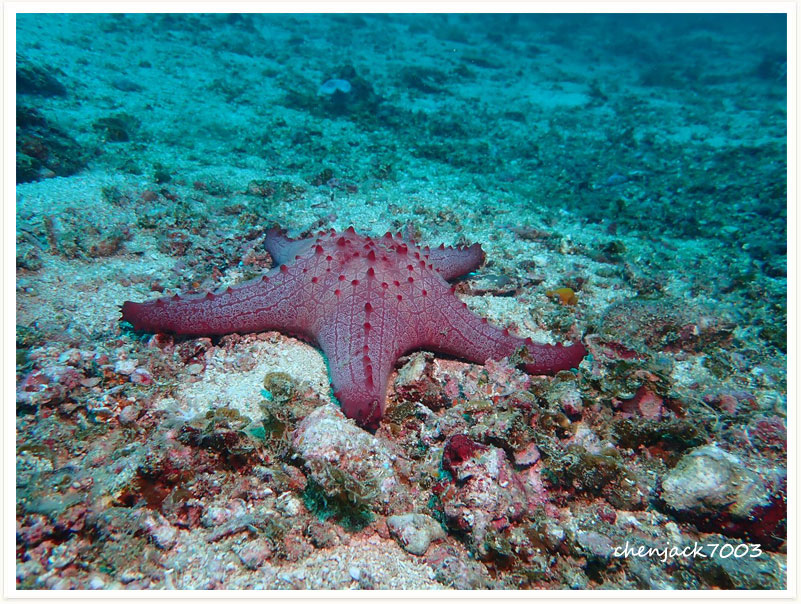
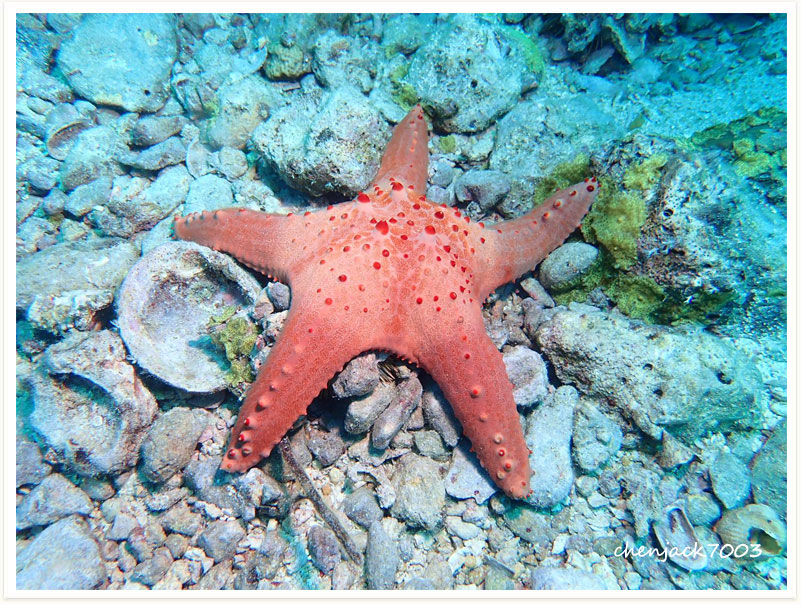
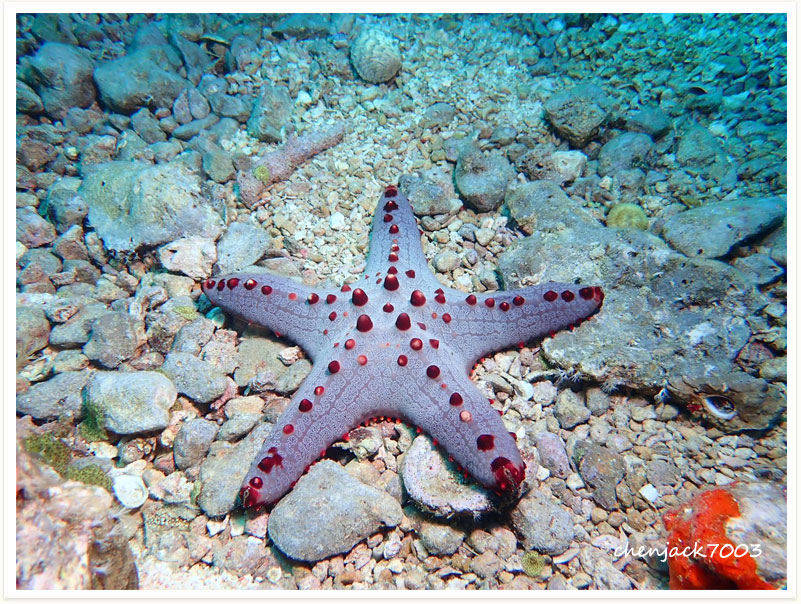
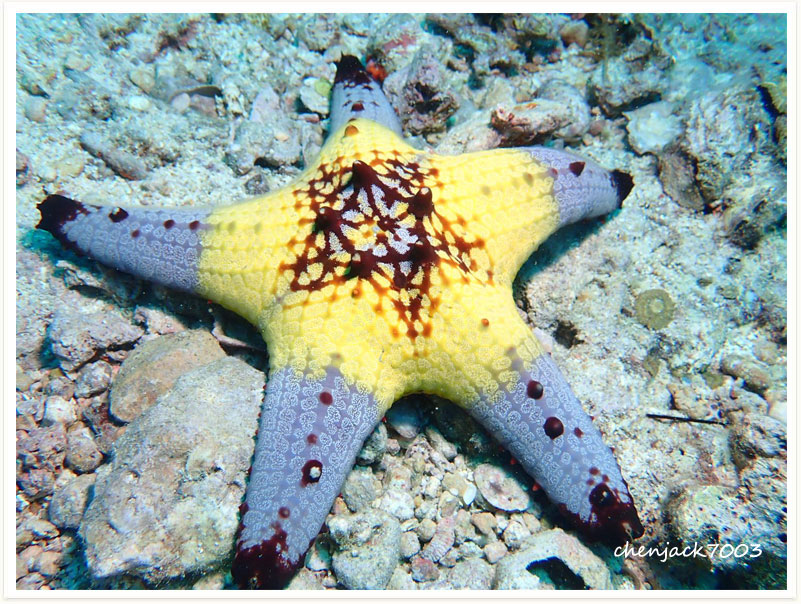
 Underwater Photography
Underwater PhotographyPentaceraster alveolatus is a starfish from the Oreasteridae family.
The scientific name of the species was published in 1875 by Edmond Perrier.





Saron marmoratus is a rather hunch-backed dumpy species of shrimp. Its rostrum is slightly longer than its carapace and is strongly recurved, it has 1 or 2 spines on its dorsal margin, followed by 3 or 4 spines on the carapace, and there are 8-10 long spines on the ventral margin of the carapace. The dorsal margin of the carapace and the abdomen have tufts of setae, which are denser in the females. The males have elongated chaelae which are longer than body and the females possess an obvious brush-like structure of setae on the first pair of legs. The legs feature brown or blue transverse bands. They are variable in colour and the ground colour can be red, blue or brown, mottled with brown or green, the legs are marked with blue or brown transverse bans.
O. scyllarus is one of the larger, more colourful mantis shrimps commonly seen, ranging in size from 3 to 18 cm (1.2 to 7.1 in). They are primarily green with orange legs and leopard-like spots on the anterior carapace.
Their ability to see circularly polarised light has led to studies to determine if the mechanisms by which their eyes operate can be replicated for use in reading CDs and similar optical information-storage devices.
The Hymenocera, or Harlequin shrimp, is usually cream colored or white with occasional spots. Around the Pacific Ocean, many of these shrimp will have red spots while the Indian Ocean shrimp typically have purple spots while its close cousin, the Hawaiian H. picta, has purple and red spots off of their body, the shrimp have two walking legs on each side and large claws, or cheliped. The claws and eyes appear to look flattened and thin. On its head the shrimp have “petal-like sensory antennules” to smell out their prey. Their body usually reaches up to 5 cm or 2 inches, and the male is just a little bit smaller than the female.
The backround colour is light blue with white longitudinal bands. On the mantle are white or crem coloured spots,as its name ‘albopustulosa’ suggests.Rhinophores are white and bright orange.

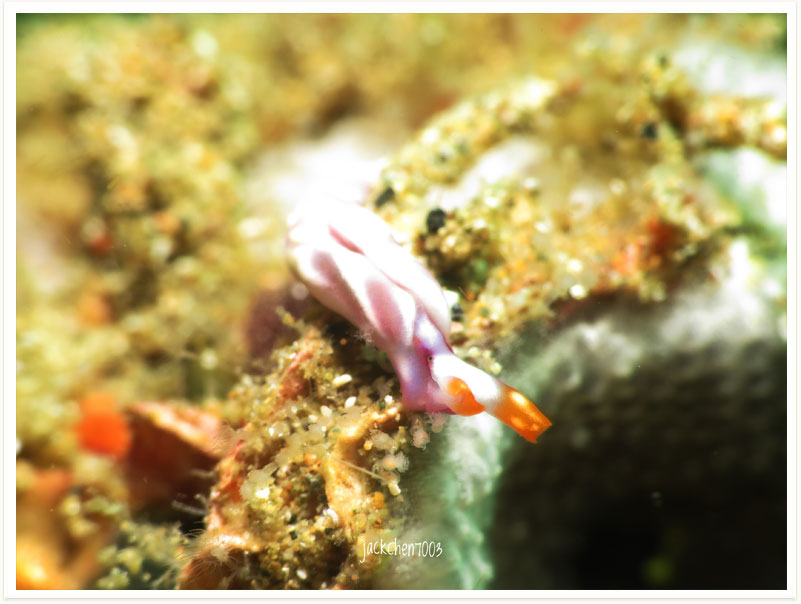
Stiliger is a genus of small and minute sacoglossan or sap-sucking sea slugs. They are marine gastropod mollusks in the family Limapontiidae.
They somewhat resemble nudibranchs, but are not closely related to them. They are a rich green in color, caused by the green algae they eat.
Samla riwo typically reaches a length of 20 mm when fully mature. It has a translucent white body covered with a lacy, white network of pigment. The oral tentacles are expanded at the tips into spear-like points or paddles. The bottom 2/3 of each of the cerata is translucent with pale peach-coloured digestive gland. Above this region there is a purple band around the ceras, followed by a white tip. The rhinophores have a bare, cylindrical basal region followed by a perfoliate club with 16-22 densely packed lamellae.
Nembrotha lineolata grows to a length of about 70 millimetres (2.8 in). The body is slender with a rounded head at one end and a pointed tip to the foot at the other. The exterior of the body is covered with longitudinal wrinkles and there is no sharp demarcation between the dorsal surface and the lateral surfaces. The oral tentacles are thick and long and the large conical rhinophores bear about thirty lamellae and can be retracted. The three large pinnate branchial plumes on the dorsal surface are non-retractile and the anus is located between them. The colouring of this nudibranch is variable across the animal’s range. The body colour is creamy-white with narrow longitudinal lines, some broken, in varying shades of brown. Sometimes these lines merge in places giving transverse bands of colour. There is a blue or purple stripe running round the margin of the foot and often a yellow one as well. The oral tentacles are blue or purple with a yellow band and the rhinophores are red (sometimes yellow in the Comoros Islands) with blue or purple sheaths.
Nembrotha chamberlaini is white with streaks of orange, yellow, green, or black and occasionally yellow splashed across the upper mantle. It has very distinctive bright red gills and rhinophores. The foot and mouth parts are typically light-purple. This nudibranch has a very characteristic color pattern which is typical of species that display warning coloration to other species.
Formerly better known as Ceratosoma miamiranum,the name is changed to Miamira miamirana.
Miamira miamirana is very variable in colour .The body colour can be a dark greenish-brown or reddish brown, or other variants.It has a relatively hard mantle with tubercles.Miamira miamirana lives on hard or sandy bottom.It is very well camouflaged and difficult to detect.
Janolus savinkini, common name purple-tipped janolus, is a colorful sea slug, an arminina (a suborder of Janolus) nudibranch, a marine gastropod mollusc in the family Proctonotidae.The body and caruncle of this species are yellow with a hue of light orange. The papillae and cerata are also this colour except for the tips, which are blue/purple, hence the common name. It is found in East Asian waters and is believed to be extremely rare in Okinawa.
A new described species. Very similar to Hypselodoris kanga and Hypselodoris infucata.
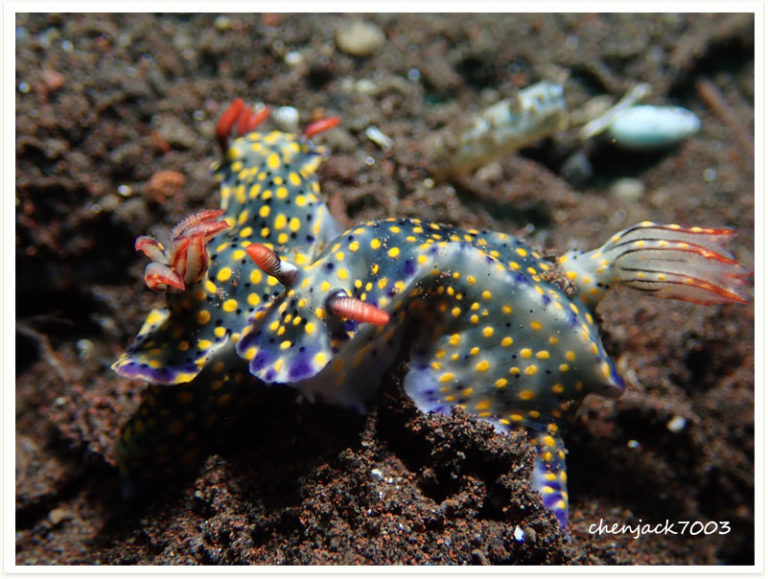
The mantle colour of is a pale milky orange-brown. On the central part of body are four white lines.The colour pattern is variable.
Hypselodoris maculosa feeds exclusively on yellow sponges from the genus Euryspongia.
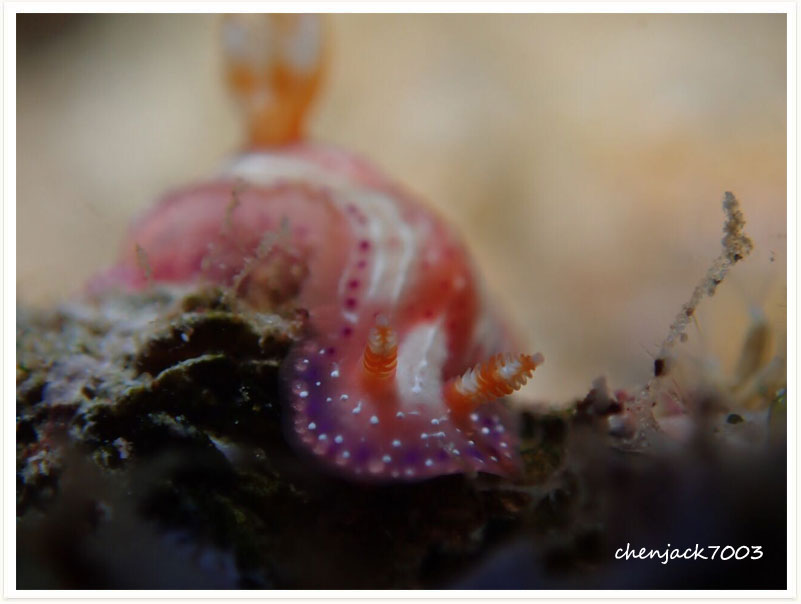
Hypselodoris infucata feeds on sponge genus Dysidea.
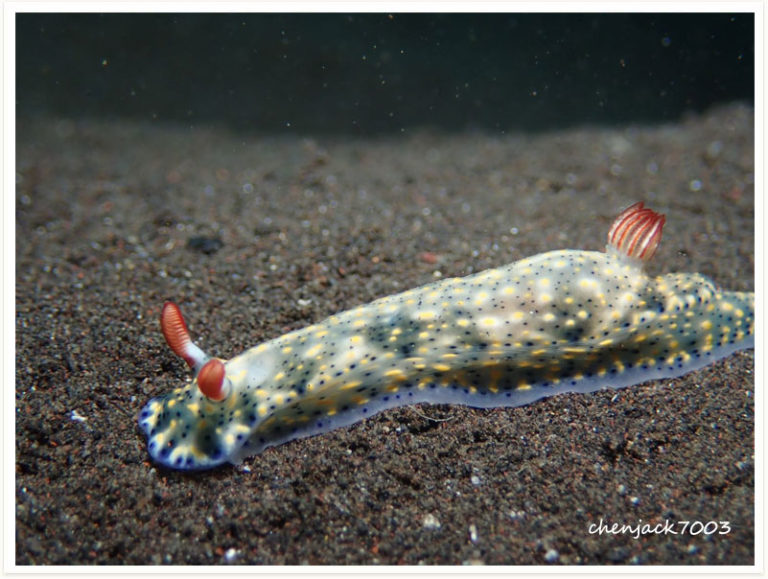
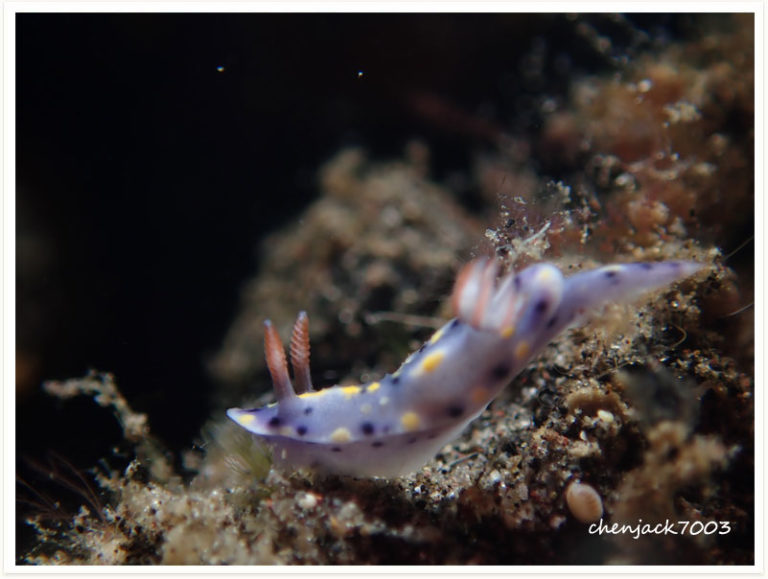
This species moves by rhythmically flapping the mantle edge up and down.

Glossodoris cincta has a mantle which is tawny brown with blue-white dots and a dark blue margin to the mantle which is separated from the brown by a thin grey line. The rhinophores are dark brown with blue-white dots. The living holotype was 60 mm (2.4 in) in length.
This nudibranch feeds exclusively on hydrozoon polyps.

Chromodoris magnifica can reach a maximum size of 60 mm (2.4 in) in length.The body is elongate with a foot which is distinct from the upper body by a skirt like mantle hiding partially the foot.[5] The branched gills and the rhinophores are orange colour and can be withdrawn into specific pockets under the skin in case of danger.[6] The specific epithet magnifica in Chromodoris magnifica means magnificent, so-named because of this nudibranch’s striking, vibrant colors.
Chromodoris annae can reach a maximum size of 5 cm length. The body is elongate with a foot which is distinct from the upper body by a skirt like mantle hiding partially the foot. The branched gills and the rhinophores are orange to yellow. The main background color is bluish, the intensity of the latter varying from blue-grey to intense blue, slightly speckled by tiny black spots. The blue dorsal side and the foot are bordered with a black line which can be discontinuous depending on the specimen. A black dash between the rhinophores distinguishes this species from similar species like Chromodoris elisabethina and Chromodoris westraliensis. The mantle edge and the foot are bordered with white and orange to yellow lines in which the width and the color intensity can vary greatly from a specimen to another.
Caloria indica have a orange body colour with blue, orange and white striped cerata.The body is narrow with a very long and pointed tail. This nudibranch has a wide distribution area and is an invasive species in Europe.Caloria indica feed exclusively on hydroids.
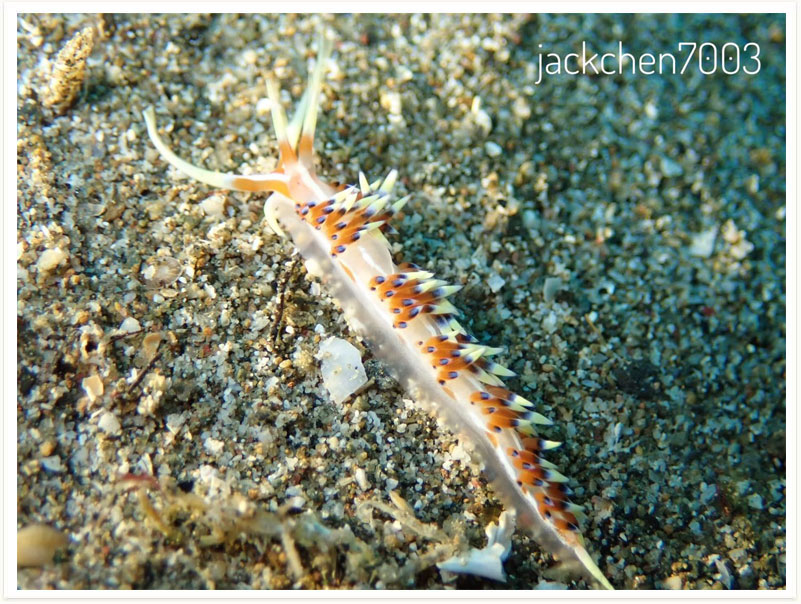
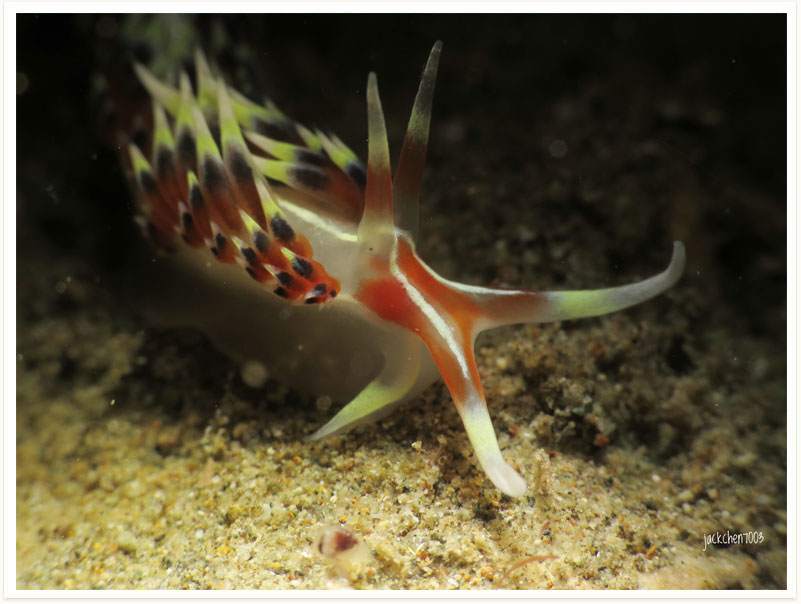
The Snakey Bornella feeds on hydroids.
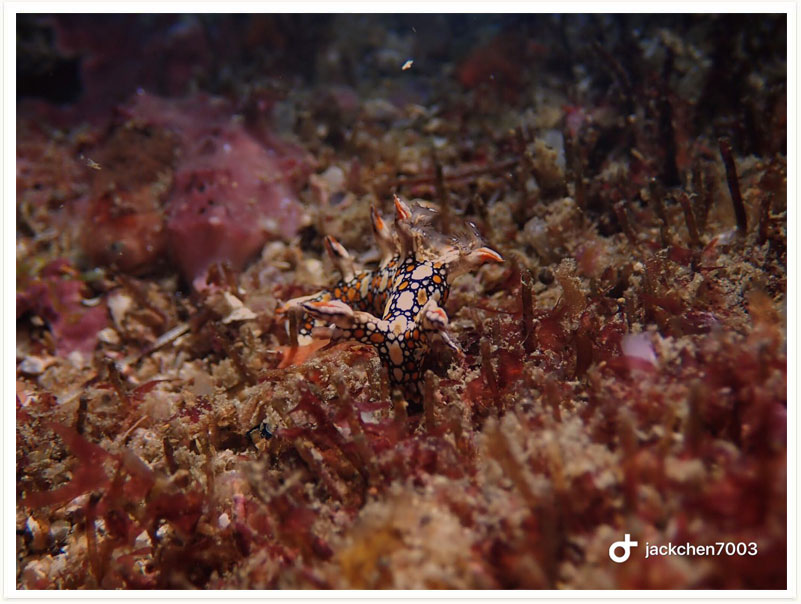
Armina semperi have a black and white longitudinal ridged body,a blue foot and yellow-orange border.This nudibranch is nocturnal and lives on sandy or silty bottom.This species usually feeds on soft corals and sea pens.
There are many similar Armina species may be mistaken.
Sea slugs of genus Aegires feeds exlusively on calcareous sponges.
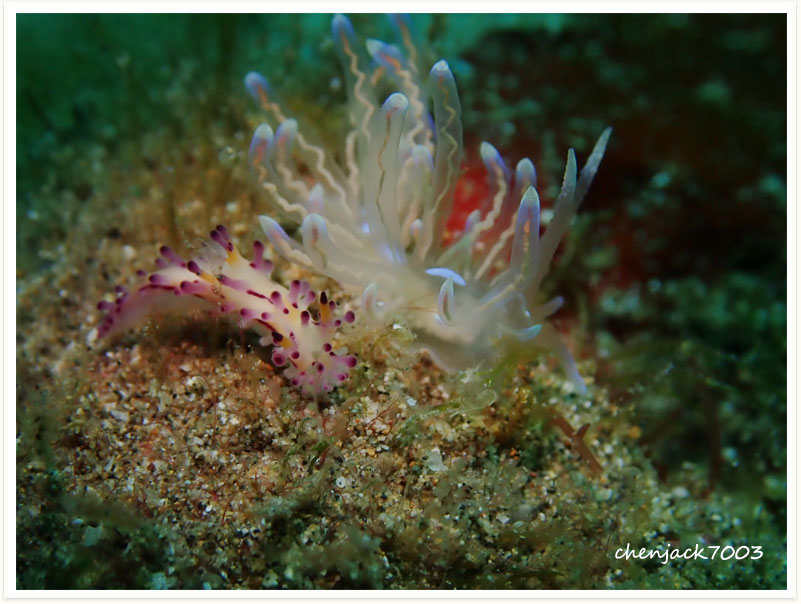
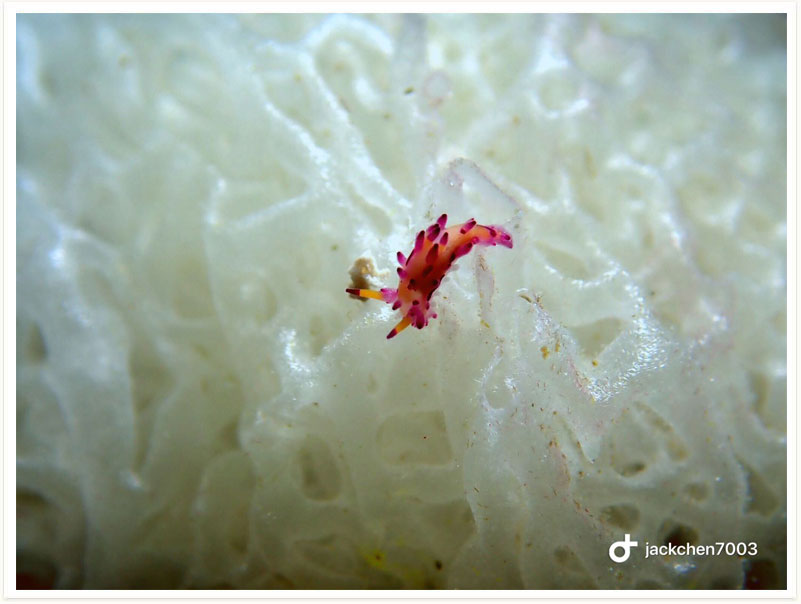
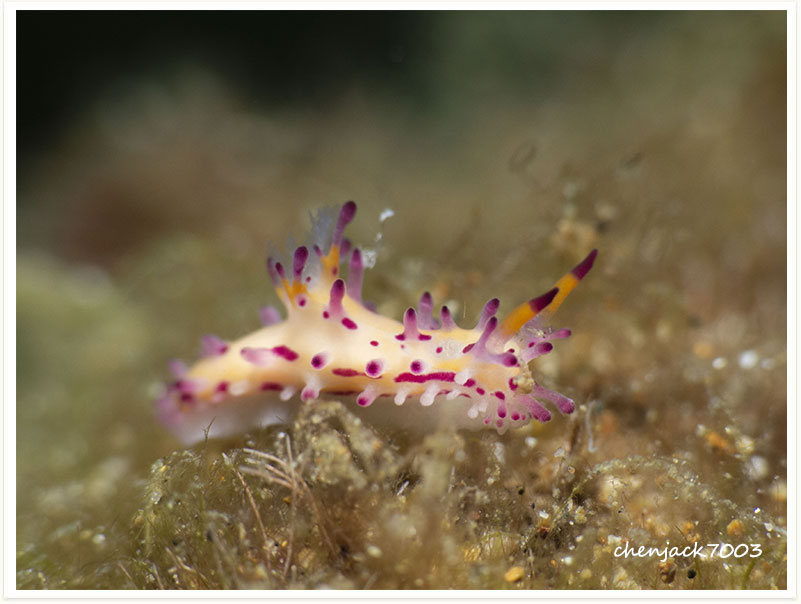
The body of the Regal Angelfish is moderately elongate and is very compressed. The preorbital bone convex and has no strong spines. There is 1 prominent spine at an angle at the preopercal. The ventral edge of the interopercle is smooth. The eyes are moderately small along with the mouth that is terminal. The mouth is also protractile. They have a maximum length of 25.0 cm.They have a total of 14 dorsal spines, and 17-19 soft dorsal rays. They have 3 anal spines and 17-19 anal soft rays. They also have 16-17 pectoral fin rays. Their caudal fin is rounded. The precise coloration of this fish can vary as regional differences can occur, most notably in populations from the Indian Ocean, Red Sea, and South Pacific Ocean. A commonality, however, is a body edged in narrow blue-white and orange stripes that are narrow and angle backward. The posterior portion of dorsal fin is black or blue with close-set blue dots, and the posterior portion of anal fin has alternating yellow and blue bands running parallel to body contour. The caudal fin is yellow. Juveniles are colored with a large dark spot on basal portion of the soft dorsal fin.[1] They have been reported of living 15 years.
The yellowmargin triggerfish, Pseudobalistes flavimarginatus, are marine fish in the triggerfish family Balistidae. They originate in coastal tropical waters and reefs of the Indo-Pacific from the Red Sea south to Natal, South Africa and east from southern Japan south to Indonesia, Philippines and Samoa. They can be found at water depths from 2–50 m (6.6–164.0 ft).
Pomacanthus annularis can reach a body length of about 45 cm (18 in), but usually the total body length get up to about 30 cm (12 in). Bodies are deeply compressed and the mouth is quite small. They have 13 dorsal spines, 20-21 dorsal soft rays, 3 anal spines and 20 anal soft rays.
This is a small wrasse, averaging 10 cm long (14 cm max). It can be recognized thanks to a wide longitudinal black stripe running along the side and eye; the back and the stomach are white (sometimes slightly yellowish). This white part changes to a bright blue on the front of the animal, while the black band widens at the tail. The young are black with an electric blue line.
The checkerboard wrasse is a small sized fish that can reach a maximum length of 27 centimetres (11 in). Both its sex and appearance change during its life, and the colouring at each stage is rather variable based on location. The body is thin, relatively lengthened and its mouth is terminal.
This species can reach 40 cm (16 in) in total length, though most do not exceed 20 cm (7.9 in).As a juvenile, it is a bright red colour with large, black-margined white spots. As an adult, it has a pink face and fins, with the exception of the tail fin, which is bright yellow. The body is green towards the anterior darkening and decorated with bright blue specks towards the caudal peduncle. The fish also gains a very bright orange anterior when it grows into adulthood, and has a drastically shaded body in the posterior region that is dotted with very bright blue spots ringed with dark blue.
The dwarf hawkfish can reach 7 cm (2.8 in) in total length. The dorsal fin has ten spines with numerous tassels on the tips of the spines. The anal fin has three spines and six soft rays. The pectoral fins are thick and elongated and spread out when the fish is resting on the substrate. This fish is pinkish-red and white in color with vertical banding or mottling.
It is a large butterflyfish, at up to 30 cm (nearly 12 in) long together with the Lined Butterflyfish (C. lineolatus) the giant among its genus. In shape it resembles certain angelfishes more than most of its relatives. The overall color is yellowish grey, with a large black spot bordered below by a broad white band on the back and wavy blue lines on the lower sides. The throat and the outline of the hind parts is bright yellow. Adults have a filament extending posteriorly from the upper part of the soft portion of the dorsal fin.
The titan triggerfish, giant triggerfish or moustache triggerfish (Balistoides viridescens) is a large species of triggerfish found in lagoons and at reefs to depths of 50 m (160 ft) in most of the Indo-Pacific, though it is absent from Hawaii. With a length of up to 75 centimetres (30 in), it is the largest species of triggerfish in its range (the stone triggerfish, Pseudobalistes naufragium, from the east Pacific is larger).
The clown triggerfish is a fish which grows up to 50 cm. Its body has a stocky appearance, oval shape and compressed laterally. The head is large and represents approximately one third of the body length. The mouth is small, terminal and has strong teeth.
Acanthurus japonicus is a tang from the Indo-West Pacific. It occasionally makes its way into the aquarium trade. It grows to a size of 21 cm in length. It is also known as Japan surgeonfish, white-faced surgeonfish, gold rim tang, powder brown tang and white-nose surgeonfish.
Calcinus is a genus of hermit crabs in the family Diogenidae
